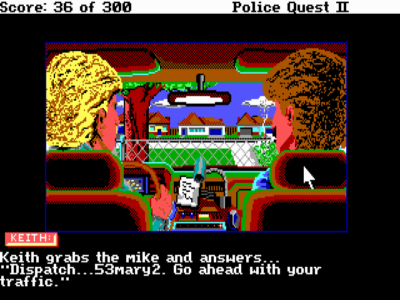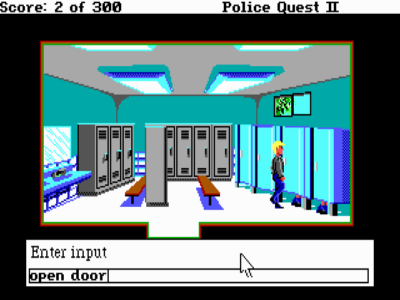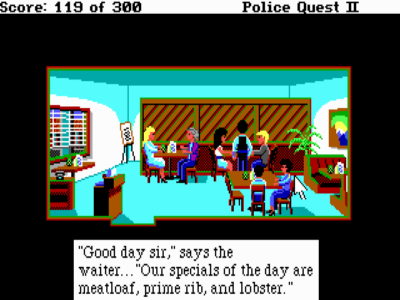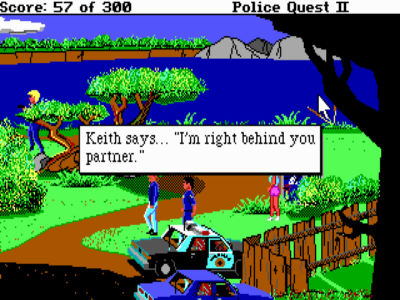
Police Quest 2: The Vengeance
Written by: Rik
Date posted: January 1, 2009
- Genre: Adventure
- Developed by: Sierra
- Published by: Sierra
- Year released: 1988
- Our score: 4
It seems that however much we’d like to avoid it, reviews of Sierra adventures on FFG seem to follow a familiar pattern: we usually start off by mentioning the fact that, way back when, we never really warmed to any of the Quest games, justify the review on the grounds that they’re “important” and need to be covered, before coming to the conclusion that, in the nicest way possible, we can’t really say that we enjoyed the experience any more than we thought we would.
It’s a habit that’s becoming hard to break, and with the realisation that there’s a telltale number at the top of this piece giving a general approximation of my feelings for this game, it seems relatively safe to admit at the outset that this one didn’t much tickle my fancy either. But before this starts to sound like the joyless (and pointless) trudge through history that our Sierra reviews are in danger of becoming, it’s perhaps worth pointing out that we’re generally more well-disposed towards the Police Quest series than the others. I had a bit of a soft spot for the first game (even though I didn’t review it) and as such approached this one with optimism and good intentions. So there.
Anyway, Police Quest II sees you return to the town of Lytton and the world of former traffic cop Sonny Bonds. Following his work in the first game in pursuing and putting away the “Death Angel” Jessie Bains, Bonds gets a promotion to the homicide division, leaving the humdrum world of traffic duty behind to focus full-time on putting away lowlife scumbag murderers. Unfortunately for him, it turns out that the local prison isn’t too hot at keeping lowlife scumbag murderers locked up, and as a result Bains manages to escape while in Lytton awaiting retrial. It seems Bains isn’t keen on legging it to Mexico without another word either, instead preferring to hang around Lytton in a threatening manner while committing the occasional knife or firearms related offence. Well, I guess he’s not called the “Death Angel” for nothing.
While the story won’t win any awards for originality, Bonds’ transfer to homicide does represent a change in emphasis from the first game, with the gameplay centred on investigating crime scenes and collecting evidence rather than handing out speeding tickets and driving to the donut shop. Bearing in mind the series’ emphasis on authenticity, backed up by the extremely serious tone of the game manual, which harps on about following the correct procedure on virtually every page, you might reasonably expect this part of the game to be quite in-depth. Allied to Sierra’s fondness for allowing you to mess up and bring the game to a premature end, I was anticipating several ‘game over’ messages because I forgot to put on some gloves before touching something (or whatever).

Thankfully, the driving sections from the first game have been removed and you’re taken to your destination automatically.
Surprisingly, though, this aspect of the game isn’t all that detailed. While you’re issued with a field kit comprising the various pieces of equipment you’ll need to take evidence from the crime scene – brushes, tape, plaster, plastic bags – the game doesn’t really require you to understand what you need to do with each of these things to progress. Once you’ve seen something, you pretty much just need to type “Get blood” or “Take print” rather than go into the minutiae of taking out the relevant equipment from your kit and using it in the correct way. You can also afford to miss a few things along the way without it necessarily being a barrier to progress – instead you’ll simply miss out on some points under the scoring system Sierra likes to use in its adventures (which personally, I couldn’t care less about).
Any mention of typing commands should give you a clue as to the kind of technology PQII uses. Yup, we’re in text parser territory here, with all the many delights that this brings. It’s also one of those games which demands that you must be standing in EXACTLY the correct place do something. Put those two things together turns performing the most simple tasks into a bit of a test of patience. The time-consuming nature of such things is also at odds with the occasionally high-octane life of a homicide detective.
For example, at one point you’re investigating a murder (I won’t say where) when Bains shows up and takes a shot at you before speeding off in his car. Clearly, you’re supposed to take chase, but any prospect of excitement soon dissipates as you fiddle about typing in the commands to put your field kit back in the boot, open the car door and use the radio to report the incident. It’s little wonder you don’t catch him.
It’s perhaps a little unfair to criticise PQII for its movement or parser idiosyncrasies – such things were common to many games of a similar vintage, where story and dialogue took a back seat to fiddly puzzles. It could also be argued here that the need to be precise and thorough is all a necessary part of police work, and if you can’t be bothered to wander around a crime scene examining things methodically then you probably shouldn’t be playing this game in the first place. On the other hand, it doesn’t readily qualify as fun either, especially when you’re forced to rely on the blocky visuals for clues on what might be worth investigating. While collecting evidence may be easy, finding the damn stuff in the first place can be more tricky.
Perhaps my greatest problem with PQII is the fact that there’s very little to it beyond the crime scene stuff and the whole game seems to revolve around giving you another murder to clean up. From very early on there’s general acceptance that Bains is the killer, but it seems so vitally important to build up a massive dossier of evidence against him that it’s actually preferable to let him kill a couple more instead of catch him right away. In-between, there are a couple of lighter moments and the odd distraction, but to be honest I generally need a little more than a couple of sentences of dialogue and the paper-thin characters on offer here to care about what’s going on.
It’s hard to avoid the conclusion that Sierra’s decision to produce a shiny VGA remake of the first game has left this one as the poor relation of the series. While the presentation is still fairly creditable, it’s dated badly in other areas, and I’m not just talking about the pastel outfits and curly mullets. As a game it’s certainly not terrible, and can be mildly diverting at times, but the functional story and fiddly gameplay ultimately make for a less than exciting experience.





 Posts
Posts